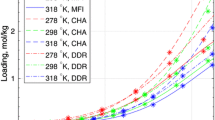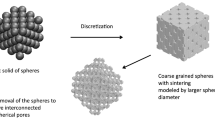Abstract
The diffusion of molecules adsorbed in a one-dimensional channel with side pockets is investigated in the framework of a one-dimensional lattice-gas model. The model can describe the molecules migration in some type of zeolites. We obtained the exact expression for the free energy of this model. Using the local equilibrium approximation we derived the analytical expressions for the diffusion coefficients. The concentration dependencies of the center-of-mass and Fickian diffusion coefficients are calculated for some representative values of the lateral interactions between molecules. The theoretical dependencies are compared with the numerical data obtained by the kinetic Monte Carlo simulations. The data obtained by the two completely different methods coincide amazingly well in the whole concentration and wide interaction regions.
Access this chapter
Tax calculation will be finalised at checkout
Purchases are for personal use only
Similar content being viewed by others
References
Ala-Nissila, T., Ferrando, R., Ying, S.C.: Adv. Phys. 51, 949–1078 (2002)
Alexandrowicz, Z.: J. Stat. Phys. 13, 231 (1975)
Arkhincheev, V.E.: Phys. A 280, 304 (2000)
Baerlocher, C., Meier, W.M., Olson, D.H.: Atlas of zeolite framework types. http://www.iza-structure.org/databases/books/Atlas 5ed.pdf
van Bekkum, H., Flanigen, E.M., Jansen, J.C. (eds.): Introduction to Zeolite Science and Practice. Elsevier, Amsterdam (1991)
Bhide, S.Y., Yashonath, S.: J. Chem. Phys. 111, 1658 (1999)
Bortz, A.B., Kalos, M.H., Lebowitz, J.L.: J. Comput. Phys. 17, 10 (1975)
Brandani, S., Ruthven, D.M., Kärger, J.: Zeolites 15, 494 (1995)
Evans, M.G., Polanyi, M.: Trans. Faraday Soc. 31, 875 (1935)
Eyring, H.: J. Chem. Phys. 3, 107 (1935)
Combariza, A.F., Sastre, G., Corma, A.: J. Phys. Chem. C 113, 11246 (2009)
Combariza, A.F., Sastre, G., Corma, A.: J. Phys. Chem. C 115, 875 (2011)
Chandrasekhar, S.: Rev. Mod. Phys. 15(1), 1 (1943)
Chumak, A.A., Tarasenko, A.: Surf. Sci. 91, 694 (1980)
Danani, A., Ferrando, R., Scalas, E., Torri, M.: Int. J. Mod. Phys. B 11, 2217–2279 (1997)
Forster, D.: Hydrodynamic Fluctuations, Broken Symmetry and Correlation Functions. Benjamin, Reading (1975)
Gupta, V., Nivarthi, S.S., McCormick, A.V., Davis, H.T.: Chem. Phys. Lett. 247, 596 (1995)
Hahn, K., Kärger, J., Kukla, V.: Phys. Rev. Lett. 76, 2762 (1996)
Harris, T.E.: J. Appl. Probab. 2, 323 (1965)
Kärger, J., Ruthven, D.M.: Diffusion in Zeolites and Other Microporous Solids. Wiley, New York (1992)
Kärger, J.: In Single-File Diffusion in Zeolites in Molecular Sieves v.7. In: Karge, H.G., Weitkamp, J., Brandani, S. (eds.) Springer, Berlin (2008)
Kärger, J., et al.: Pure Appl. Chem. 61, 1875 (1989)
Metropolis, N., Rosenbluth, A.W., Teller, A.H., Teller, E.: J. Chem. Phys. 21, 1087 (1953)
Moore, J.D., et al.: Appl. Surf. Sci. 256, 5131 (2010)
Novotny, M.A.: In: Annual Reviews of Computational Physics IX. Stauffer, D. (ed) (World Scientific, Singapore, 2001), p. 153. Also see at http://www.arxiv.org/cond-mat/ 010918
Pikunic, J., Gubbins, K.E.: Eur. Phys. J. E 12, 35 (2003)
N. Pottier, Nuovo Cimento 16 D (1994)
N. Pottier, Physica A 216 D (1995) 1
Reed, D.A., Ehrlich, G.: Surf. Sci. 102, 588 (1981)
Tarasenko, A., Jastrabik, L., Muller, T.: Phys. Rev. B 75, 085401 (2007)
Tarasenko, A., Jastrabik, L., Muller, T.: Phys. Rev. B 76, 134201 (2007)
Tarasenko, A., Jastrabik, L.: J. Phys. C 20, 415210 (2008)
Tarasenko, A., Jastrabik, L.: Surf. Sci. 602, 2975 (2008)
Tarasenko, A., Jastrabik, L.: Phys. A 388, 2109 (2009)
Tarasenko, A., Jastrabik, L.: Phys. Chem. Chem. Phys. 11, 7690 (2009)
Tarasenko, A., Jastrabik, L.: Phys. A 75, 085401 (2011)
Tarasenko, A., Jastrabik, L., Nieto, F., Uebing, C.: Phys. Chem. Chem. Phys. 1, 1583 (1999)
Tarasenko, A., Nieto, F., Jastrabik, L., Uebing, C.: Eur. Phys. J. D 12, 311 (2000)
Tarasenko, A., Jastrabik, L., Uebing, C.: Phys. Rev. B 57, 10166 (1998)
Tarasenko, A., Jastrabik, L., Nieto, F., Uebing, C.: Phys. Rev. B 65, 075413 (2001)
Tarasenko, A., Nieto, F., Jastrabik, L., Uebing, C.: Surf. Sci. 536, 1 (2003)
Tunca, C., Ford, D.M.: Chem. Eng. Sci. 58, 3373 (2003)
White, S.R., Barma, M.: J. Phys. A 17, 2995 (1984)
Weiss, G., Havlin, S.: Phys. A 134, 474 (1986)
Acknowledgments
This work was supported by the Operational Program Research and Development for Innovations–European Social Fund (project CZ.1.05/2.1.00/03.0058 of the Ministry of Education, Youth and Sports of the Czech Republic) and by grants TA01010517 of the TACR and P108/12/1941 of the GACR.
Author information
Authors and Affiliations
Corresponding author
Editor information
Editors and Affiliations
Appendix
Appendix
We derive here the analytical expression for the diffusion coefficient for molecules performing the long jump successions. In the low concentration region \( \left( {\theta < p/(p + 1)} \right) \) all molecules occupy deep pocket sites. We need the probability of a molecule jump succession from some initial \( i \)th to the final \( f \)th \( d \) site. The molecule performs slow jump from the \( i \)th site, \( n \) fast jumps and occupies the \( f \)th site at the distance \( ma \) from the \( i \)th site. The probability of this succession is a product of the probabilities of the elementary migration acts: the probability of the first slow jump from the \( i \)th to the channel \( s \) site \( \nu {\text{exp}}( - \varepsilon_{p} ), \) the probability of the sequence \( n \) fast jumps \( W(n,m) \) and the probability to occupy a \( d \) site by the final jump \( w_{d} \). As we supposed that the probability for a fast jump is equal for all NN sites, then the probability to jump in the NN \( s \) site is \( w = [p(1 - \theta_{p} ) + 2]^{ - 1} . \) The probability to occupy a \( d \) site is \( w_{p} = p(1 - \theta_{p} )[p(1 - \theta_{p} ) + 2]^{ - 1} . \) The probability of the fast jump succession is simply the product of the fast jump rates \( w^{n} . \) The number of the different jump successions which transfer the molecule to a distance \( ma \) after \( n \) jumps is equal to
where \( {\text{C}}_{k}^{{{\kern 1pt} n}} \) is the binomial coefficient.
The square of the length of this jump sequence \( L^{2} (n,m) \) is obviously equal to \( (ma)^{2} . \) To obtain the effective jump length \( L \) one should average over all sequences
The inner sum is equal \( n\;2^{{{\kern 1pt} n}} \) [13]. The infinite geometric series is easily calculated. The final result is the following simple expression
Rights and permissions
Copyright information
© 2012 Springer-Verlag Berlin Heidelberg
About this chapter
Cite this chapter
Tarasenko, A., Jastrabík, L. (2012). Study of Diffusion in a One-Dimensional Lattice-Gas Model of Zeolites: The Analytical Approach and Kinetic Monte Carlo Simulations. In: Delgado, J., de Lima, A., da Silva, M. (eds) Numerical Analysis of Heat and Mass Transfer in Porous Media. Advanced Structured Materials, vol 27. Springer, Berlin, Heidelberg. https://doi.org/10.1007/978-3-642-30532-0_3
Download citation
DOI: https://doi.org/10.1007/978-3-642-30532-0_3
Published:
Publisher Name: Springer, Berlin, Heidelberg
Print ISBN: 978-3-642-30531-3
Online ISBN: 978-3-642-30532-0
eBook Packages: Chemistry and Materials ScienceChemistry and Material Science (R0)




